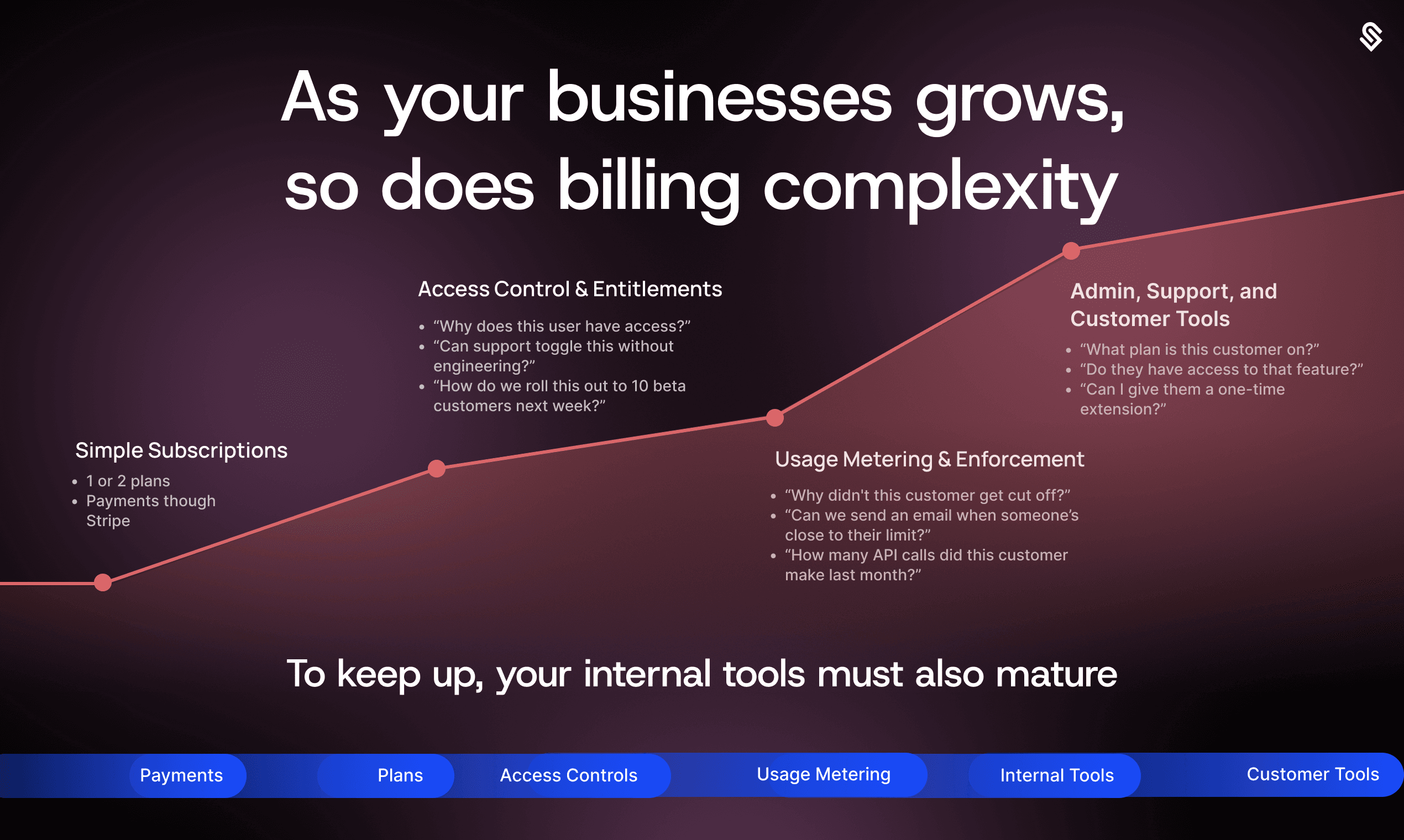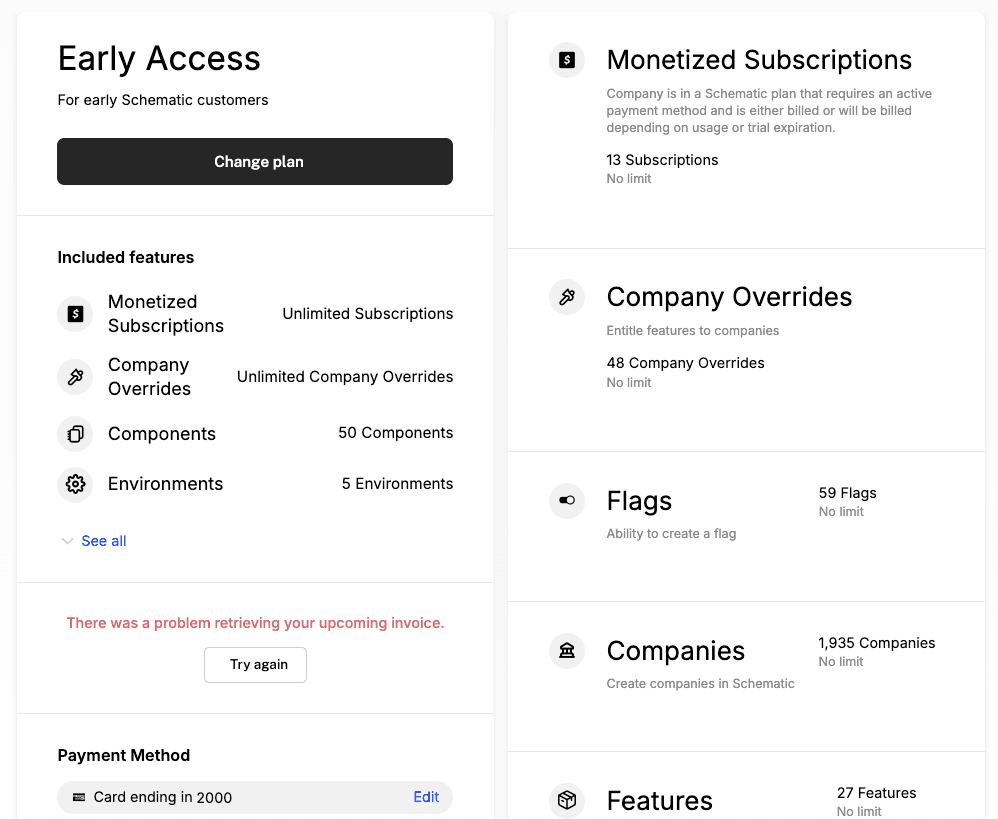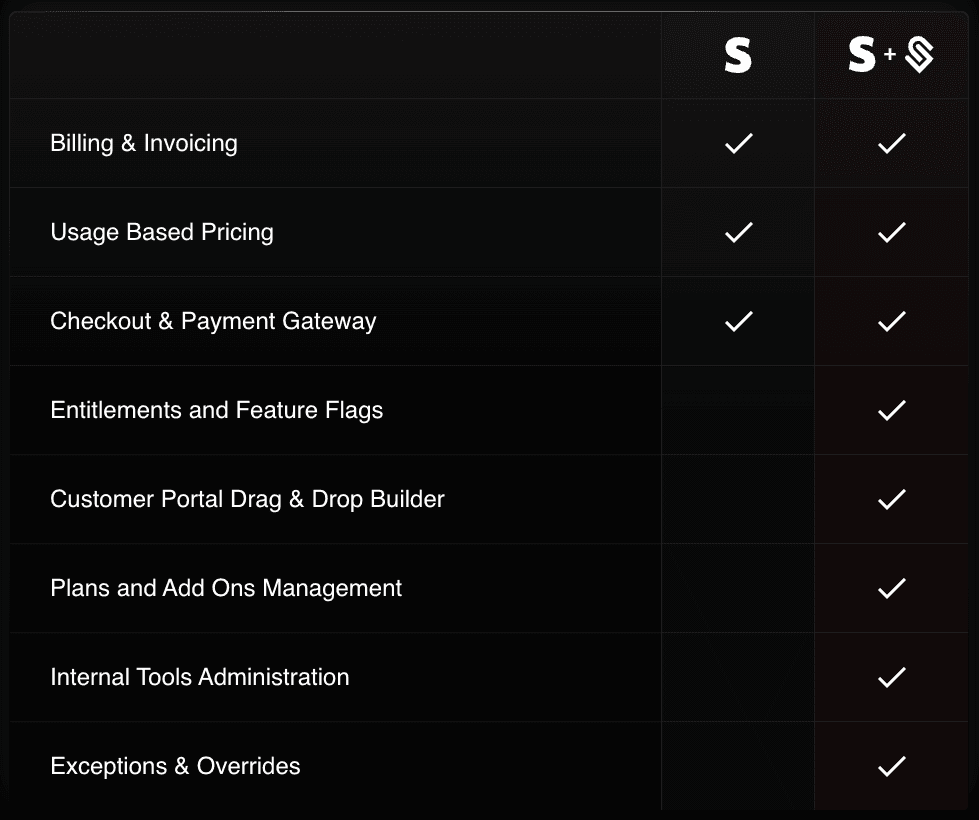Most engineering teams don’t set out to build a billing system. They just want to launch.
So they wire up Stripe Checkout. Maybe define a couple of plans. Add some metadata for access control. Ship it.
But there’s no clear standard for how to implement monetization. No Rails for pricing logic. No Terraform for entitlements. So teams improvise — and end up reinventing brittle, ad hoc billing systems that are hard to maintain and harder to scale.
It’s not just inefficient. It’s dangerous infrastructure debt, and it compounds fast.
If we had to build it ourselves, it might be a three, four-month project where we wouldn't be focusing on new capabilities for our customers -Andy Barker, Pagos

Without a blueprint, you just start wiring things together. And before long, you’ve built an entire billing stack. Here’s what that usually looks like:
Access Control & Entitlements
At first, it’s simple:
if company.plan == 'pro':
allow_export = TrueIt works. It ships. And you move on.
But then:
You want to let a free user try out a paid feature temporarily.
Sales needs to unlock a feature early for a big customer.
A PM asks for a way to test feature gating in staging.
Suddenly, what started as a simple plan check becomes a tangle of special cases, overrides, and exceptions. Access logic is no longer predictable — it’s conditional, brittle, and scattered across services.
if (company.plan in ['pro', 'enterprise', 'growth'] or
company.id in [12345, 67890] or
company.trial_flags.get('export') == True or
company.custom_flags.get('export_enabled') == True):
allow_export = True
else:
allow_export = FalseThere’s no audit trail. No way to see who has what. No way to answer simple questions like:
“Why does this user have access?”
“Can support toggle this without engineering?”
“How do we roll this out to 10 beta customers next week?”
This isn’t just messy, it creates drag across the entire company. Experiments become risky, custom deals require manual work, and support teams are stuck waiting on engineers to make even the simplest access changes.
Usage Metering & Enforcement
You introduce usage-based pricing — maybe for API calls, exports, or monthly active users. So you start tracking usage. You write custom aggregation logic. You sync usage events to Stripe. You add manual resets, alerts, and frontend checks.
What seemed like a small addition becomes a system of its own. You start hearing questions like:
“Why didn't this customer get cut off when they hit their usage limit?”
“Can we send an email when someone’s close to their limit?”
“How many API calls did this customer actually make last month, and what did we charge them for?”
Now you have usage logic in your backend, your frontend, your Stripe integration, and maybe your alerting service too. There’s no single source of truth. Different parts of the stack have different views of what a customer has used, and whether they should still have access.
It’s not just hard to maintain. It’s hard to trust.
Admin, Support, and Customer Tools
Eventually someone asks:
“What plan is this customer on?”
“Do they have access to that feature?”
“Can I give them a one-time extension?”
At first, you answer those questions manually — maybe with SQL, maybe by digging through Stripe.
Then the questions keep coming. So you build an internal tool to surface plan details. Then a dashboard to show usage. Then a quick way to toggle flags. Before long, you’ve built a support panel. And a customer portal. And probably a spreadsheet to track overrides, just in case.
But it’s not just your team asking for visibility — your customers want it too. They want to see what plan they’re on, how much they’ve used, what’s included, and what happens next. So now you’re maintaining UI components for usage meters, upgrade paths, and threshold alerts.
These tools aren’t optional. They’re necessary to keep the business running, but they’re expensive to build, brittle to maintain, and often locked away behind engineering. Every new feature or plan change means updating all the tools you duct-taped together last quarter.
What started as “just a couple of plans” now requires infrastructure just to answer basic questions about access, usage, and entitlements.

Most teams don’t set out to build billing infrastructure — they just take one step at a time. What they don’t realize is that there’s a better way. Not because they’re doing it wrong, but because they don’t know that modern monetization platforms like Schematic exist.
Schematic gives you a foundation that turns ad hoc logic into real infrastructure:
A structured entitlement system, so access control is consistent, auditable, and easy to manage.
Centralized usage metering and enforcement, so you can charge based on consumption — without stitching together backend counters and cron jobs.
Flexible plan configuration and overrides, so trials, custom add-ons, and mid-cycle upgrades don’t require manual exceptions or code changes.
Built-in admin and customer portals, so support and success teams can do their jobs without filing tickets or asking for SQL access.

Instead of hiding logic in Stripe metadata, scattered flags, or backend conditionals, you manage monetization through a clean, purpose-built system. Instead of reinventing billing tools, you configure the ones you need. And instead of requiring engineering for every plan change, trial extension, or sales exception, GTM teams handle it themselves.
For engineers, that means fewer Slack pings, fewer one-off scripts, and fewer billing-related bugs. You spend less time maintaining brittle logic and more time building the product that actually moves the business forward.
It’s not just leverage for the business — it’s freedom for the team.
There’s no standard playbook for monetization — which is exactly why most teams fall into the same traps. But billing isn’t your product. It’s infrastructure. Just like auth, observability, or CI.
The longer you delay investing in it, the more glue code, tech debt, and edge cases you’ll accumulate. And the more painful it’ll be to replace later.
Don’t build the billing system you’ll one day need to rip out.Build the product your customers are actually paying for.
Why shouldn’t I build my own billing infrastructure if I have the technical skills? Because billing is complex, non-differentiated infrastructure. Even simple implementations snowball into hard-to-maintain systems with scattered entitlements, inconsistent usage tracking, and mounting technical debt that distracts from building your core product.
What problems arise when billing is built incrementally in-house? Teams often start small—hardcoding entitlements or syncing Stripe metadata—but quickly accumulate fragile logic, manual workarounds, and brittle tools for access control, usage enforcement, and support. This slows down experimentation, introduces bugs, and burdens engineering.
Why is usage-based pricing especially hard to get right in a DIY system? Tracking usage across services, syncing to Stripe, enforcing limits, and supporting alerts requires backend logic, frontend checks, resets, and custom dashboards. Without a single source of truth, usage becomes hard to trust and hard to act on.
What’s the impact of homegrown billing tools on support and GTM teams? Internal teams lack visibility, rely on engineering to answer basic questions, and can't manage trials, add-ons, or plan changes without code involvement. This creates operational drag and delays revenue-generating initiatives.
How does Schematic solve these problems? Schematic provides a structured entitlements system, centralized usage tracking and enforcement, flexible plan configuration, and built-in tools for support and customer visibility — all without requiring engineering for every change.
When is the right time to invest in a billing platform like Schematic? As soon as you need to enforce limits, support usage-based pricing, run trials, or let GTM teams manage plans without code — ideally before you’ve hardcoded logic that will be painful to unwind later.